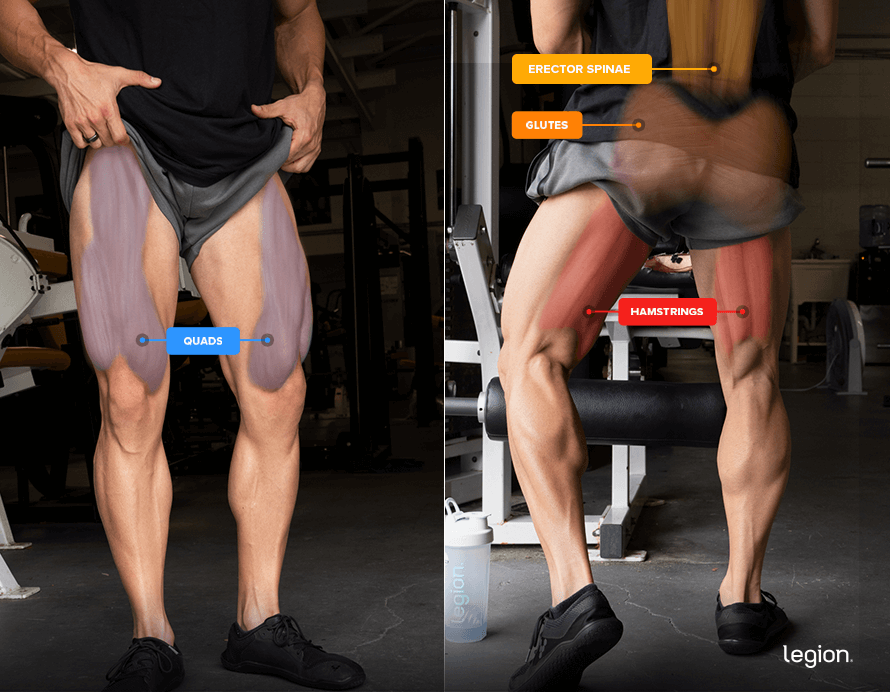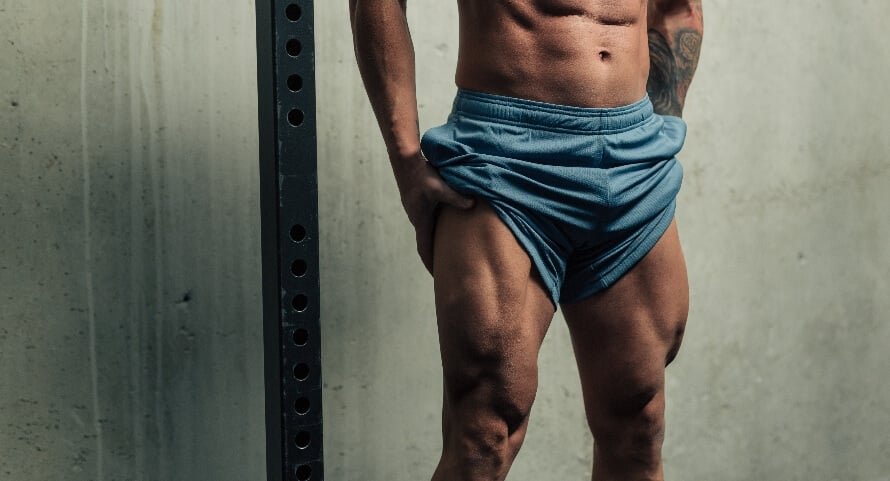Field squats are an efficient and knee-friendly various to conventional squats.
They’re useful as a result of they “groove in” correct squat method, develop explosive power, and enable you overcome power plateaus.
On this knowledgeable information, you’ll study what field squats are, how you can do a field squat with correct type, the advantages of field squats, which muscle mass they work, widespread errors to keep away from, the very best options, and extra.
What Are Field Squats?
The field squat is a variation of the common squat, which includes squatting down till you’re sitting on a field positioned behind you, after which standing again up.
It has two primary makes use of:
- Novice weightlifters: For novices, field squats are nice for studying correct squat type. The field guides them to squat to the precise depth and helps with steadiness.
- Skilled weightlifters: Superior weightlifters incorporate field squats to refine their method. The pause on the backside of every rep additionally helps construct the ability wanted to push by way of the toughest a part of the squat—the purpose at which you start to face up from the underside place, often known as the “gap.”
Do a Field Squat with Correct From
Comply with these steps to discover ways to do a field squat with correct type:
1. Arrange
Place a barbell in a squat rack at mid-chest top and place a sturdy knee-high field or bench 1-to-2 toes behind the rack.
Step beneath the bar, pinch your shoulder blades collectively, and relaxation the bar straight above the bony ridges on the underside of your shoulder blades.
Elevate the bar out of the rack, take a step or two backward, place your heels 1-to-3 inches from the field, and place your toes barely wider than shoulder-width aside along with your toes pointed barely outward.
2. Descend
Take a deep breath into your abdomen, push your chest out, brace your core, and sit down by bending on the knees and hips on the similar time. Proceed sitting down till your butt is on the field.
3. Squat
Drive by way of your toes to face up and return to the beginning place. This mirrors what you probably did through the eccentric section (the descent).
Right here’s the way it ought to look whenever you put all of it collectively:
The Advantages of Field Squats
Listed below are the three primary advantages of field squats:
1. They’re gentler in your knees.
Because of the mechanics of the field squat, your shins remain extra upright, and your knees bend lower than with different forms of squat, which reduces the stress in your knees.
Regardless of this, studies present that field squats are simply as efficient as common, free squats for coaching your legs.
2. They enable you refine squat method.
Field squats enable you refine your method in 3 ways:
- They guarantee your squat depth is right on every rep, enhancing your method’s consistency.
- They train you to take care of an upright higher physique, which helps you study to steadiness appropriately whereas squatting.
- They forestall the over-reliance in your “stretch reflex.” In different phrases, whenever you separate the reducing and lifting phases of the train by sitting on a field, you scale back your means to make use of momentum, which helps you develop the management and coordination to squat correctly.
3. They enable you overcome plateaus.
Field squats are a robust instrument for overcoming power plateaus as a result of they can help you strengthen the purpose of the train the place you’re weakest—getting “out of the outlet.” By coming to a lifeless cease on the backside of every rep, they enable you develop explosive power, which is essential for enhancing your general squat efficiency.
Field squats additionally pressure you to make use of correct, environment friendly method, which helps you progress by way of intervals of stagnation.
Furthermore, field squats enhance your confidence when lifting heavy weights. Since you could management the burden for longer, it helps you overcome the concern of squatting with heavy hundreds.
Muscle mass Labored by Field Squats
Field squats primarily prepare the quads and the posterior chain (the muscle mass on the again of your physique), particularly the decrease again, hamstrings, and glutes.
Additionally they work the abs and calves to a lesser diploma.
Right here’s how the principle muscle mass labored by field squats look in your physique:

Frequent Field Squat Errors
1. “Bouncing” off the field.
The issue: Some weightlifters mistakenly assume that by quickly descending within the field squat, you’ll be able to “bounce” or “rebound” off the field to make lifting the burden simpler. Nevertheless, doing so reduces the train’s effectiveness, makes sustaining correct type tougher, and will increase your threat of damage.
The repair: To stop bouncing, management your descent and pause whenever you sit on the field, stopping all momentum. Then, make sure you’re balanced and steady earlier than standing up.
2. Utilizing a field that’s too excessive or too low.
The issue: Utilizing an inappropriately tall field can enormously scale back the train’s effectiveness and, in some eventualities, might improve your threat of damage.
The repair: Use a field that’s the precise top to your bodily talents and health targets. For instance, you probably have knee points, experiment with containers taller than knee top to search out one which permits you to prepare your legs with out discomfort.
Conversely, select a field under knee top to extend your squat power by way of the lowest level of every rep. It will can help you prepare by way of probably the most difficult vary of movement, enhancing your squat efficiency.
3. Pausing for too lengthy.
The issue: Whereas a short pause is useful for growing explosive power and studying management, an prolonged pause can disrupt the train’s circulate and scale back its effectiveness. It might probably additionally result in pointless pressure on the decrease again.
The repair: Purpose for a short pause of a couple of second. This is sufficient to remove momentum, however not so lengthy that you just threat type breakdown or damage.
The Finest Field Squat Variations and Options
1. Low Field Squat
The low field squat includes sitting on a field decrease than knee top. This will increase the train’s vary of movement, engaging the glutes and hamstrings to a larger diploma.
The elevated problem and prolonged vary of movement make the low field squat a great selection for these seeking to get stronger out of the outlet.
2. Excessive Field Squat
Within the excessive field squat, you squat onto a field greater than knee top, shortening the train’s vary of movement and additional decreasing the stress on the knees.
The excessive field squat is useful for many who want a much less difficult squat variation or have mobility or damage issues.
3. Dumbbell Field Squat
The dumbbell field squat is a viable variation in the event you solely have entry to dumbbells. That stated, you’ll be able to elevate extra weight on the barbell field squat than the dumbbell field squat, making the barbell model higher for gaining muscle and power.
4. Body weight Field Squat
The body weight field squat is a perfect place to begin for novices as a result of it permits you to apply squatting type with out added resistance.
5. Bulgarian Break up Squat
The Bulgarian cut up squat is a extremely efficient squat variation that’s kinder to the knees than common squats, making it a wonderful selection for these with knee points.
6. Step-Up
Equally to the field squat, the dumbbell step-up is an outstanding train for the complete decrease physique.
Furthermore, the dumbbell step-up doesn’t require you to elevate heavy weights to reap the advantages of the train, which implies it’s kinder to your bones and joints than different squat variations.
7. Goblet Field Squat
The field goblet squat is an effective exercise for coaching your total decrease physique, notably your quads. Since you maintain the burden in your fingers slightly than throughout your shoulders, it’s additionally simpler in your again and knees than different squat variations.
FAQ #1: Why do powerlifters do field squats?
Powerlifters do field squats as a result of they assist construct explosive power, particularly from the underside of the squat. Additionally they assist enhance squatting method and might goal particular weak factors in your squat.
FAQ #2: Do you sit throughout a field squat?
Sure, you briefly sit on the field within the field squat. You decrease your self till your butt touches the field, pause for a beat to cease all momentum, after which stand again up.
You need to maintain the pause quick, although—something greater than a second or so is simply too lengthy and will improve the percentages your type will break down. The aim of the pause is to remove momentum, to not take a relaxation.
FAQ #3: Is a field squat more durable than an everyday squat?
Squatting onto a field will be more durable than an everyday squat as a result of beginning the ascent from a lifeless cease requires extra management and power. It additionally removes the pure “bounce” that helps in common squats, making your muscle mass work more durable.
That stated, you’ll be able to sometimes squat greater than you’ll be able to field squat, which minimizes the distinction.
+ Scientific References
- Swinton, Paul A., et al. “A Biomechanical Comparison of the Traditional Squat, Powerlifting Squat, and Box Squat.” Journal of Strength and Conditioning Research, vol. 26, no. 7, July 2012, pp. 1805–1816, https://doi.org/10.1519/jsc.0b013e3182577067.
- Fry, Andrew C., et al. “Effect of Knee Position on Hip and Knee Torques during the Barbell Squat.” The Journal of Strength & Conditioning Research, vol. 17, no. 4, 1 Nov. 2003, pp. 629–633, journals.lww.com/nsca-jscr/Abstract/2003/11000/Effect_of_Knee_Position_on_Hip_and_Knee_Torques.1.aspx.
- McBride, Jeffrey M, et al. “Comparison of Kinetic Variables and Muscle Activity during a Squat vs. a Box Squat.” Journal of Strength and Conditioning Research, vol. 24, no. 12, Dec. 2010, pp. 3195–3199, https://doi.org/10.1519/jsc.0b013e3181f6399a. Accessed 13 Mar. 2020.
- Caterisano, Anthony, et al. “The Effect of Back Squat Depth on the EMG Activity of 4 Superficial Hip and Thigh Muscles.” Journal of Strength and Conditioning Research, vol. 16, no. 3, 1 Aug. 2002, pp. 428–432, pubmed.ncbi.nlm.nih.gov/12173958/.
- Kubo, Keitaro, et al. “Effects of Squat Training with Different Depths on Lower Limb Muscle Volumes.” European Journal of Applied Physiology, vol. 119, no. 9, 22 June 2019, https://doi.org/10.1007/s00421-019-04181-y.
- Jones, Margaret T, et al. “Effects of Unilateral and Bilateral Lower-Body Heavy Resistance Exercise on Muscle Activity and Testosterone Responses.” Journal of Strength and Conditioning Research, vol. 26, no. 4, Apr. 2012, pp. 1094–1100, https://doi.org/10.1519/jsc.0b013e318248ab3b.
- DeFOREST, Bradley A., et al. “Muscle Activity in Single- vs. Double-Leg Squats.” International Journal of Exercise Science, vol. 7, no. 4, 2014, pp. 302–310, pubmed.ncbi.nlm.nih.gov/27182408/.
- MACKEY, ETHAN R., and BRYAN L. RIEMANN. “Biomechanical Differences between the Bulgarian Split-Squat and Back Squat.” International Journal of Exercise Science, vol. 14, no. 1, 1 Apr. 2021, pp. 533–543, www.ncbi.nlm.nih.gov/pmc/articles/PMC8136570/.
- Simenz, Christopher J., et al. “Electromyographical Analysis of Lower Extremity Muscle Activation during Variations of the Loaded Step-up Exercise.” Journal of Strength and Conditioning Research, vol. 26, no. 12, Dec. 2012, pp. 3398–3405, https://doi.org/10.1519/jsc.0b013e3182472fad.
- Selseth, Angie, et al. “Quadriceps Concentric EMG Activity Is Greater than Eccentric EMG Activity during the Lateral Step-up Exercise.” Journal of Sport Rehabilitation, vol. 9, no. 2, May 2000, pp. 124–134, https://doi.org/10.1123/jsr.9.2.124. Accessed 9 May 2021.
- Krause Neto, Walter , et al. Gluteus Maximus Activation during Common Strength and Hypertrophy Exercises: A Systematic Review. Mar. 2020.
- Collins, Kyle S., et al. “Differences in Muscle Activity and Kinetics between the Goblet Squat and Landmine Squat in Men and Women.” Journal of Strength and Conditioning Research, vol. Publish Ahead of Print, 2 Aug. 2021, https://doi.org/10.1519/jsc.0000000000004094.

